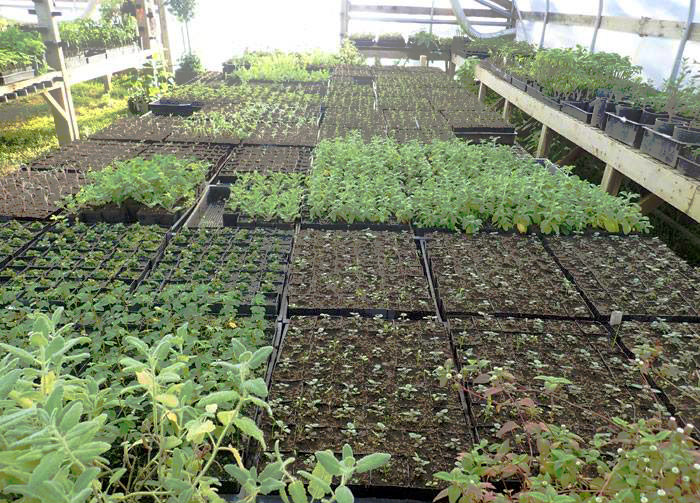Know your seed. Examine the seed before planting. Large seeds, especially those from the Legume (Fabaceae) family, have impermeable seed-coats that may require scarification (nicking or rubbing) before planting. Smaller seeds in the Lamiacea (the mint family) also appreciate scarification to wake them up — rub on a #8 seed-screen or on medium grit sandpaper. Needle-like seeds in the Asteracea (the aster family) are never scarified. They need a rich potting soil and germinate in warm temperatures. Observing the size and shape of the seed before you plant it will help you identify the seed and differentiate it from impostors when it comes up.
Know your plant. If you understand the native growing conditions for the plant you are working with, this usually translates to an understanding of the proper soil mix for planting the seeds. White Sage (Salvia apiana) is a desert plant, therefore planting in sand and keeping in the strong light much improves the likelihood that the seed will germinate in domestic culture.
Seeds require a sense of place. Seed plantings must be tamped in order to assure that the seeds stays in the original orientation, does not float away when watered, and does not shift over time and waste precious energy in re-orienting its emerging root. This generally means:
- A fast-draining mix (incorporate white pumice and coarse, sharp sand to your potting soil or simply plant in coarse, sharp sand). Use chicken grit (ground sharp stone) purchased at your feed-and-seed or check local quarries. You can provide nutrients later.
- Watering should be done in such a way as to not dislodge the seed. For small seeds, rough-up the surface of the flat, sprinkle the seeds in a well-defined row, label assiduously, tamp (press) the seeds down into the mix, and water sparingly at first. The matrix will swell around the seed and hold it in place. Water again to be sure the seeds have enough moisture to imbibe and germ. Water again only after the surface begins to dry. Do not float the seeds with excessive watering.
Damping-off. Understand that seeds will germinate and then keel over if they are watered too often, especially if temperatures are cool, but sometimes also in warm flats. Thin seedlings to a reasonable distance to promote their health and provide resistance to pathogens (e.g. phytophthora).
Even warmth vs. oscillating temps. Most garden annuals (e.g. tomatoes and peppers) are going to do best in a rich mix with warm temps (~70 degrees F). Lettuce will not germinate if temperatures reach 80 degrees F. Many permaculture trees and herbaceous perennials will do best in a cold greenhouse where the temperatures are cold at night and warm during the day. Outdoor treatment is another good way to assure temperature oscillation. For example, with Aconite, Hawthorn, Elderberry or Spikenard, set the flat of seeds in the shadehouse in the fall or early spring and allow the large cycle (winter to spring) and short-cycle (night to day) to work on the seeds until they finally germinate. Hawthorn seeds germinate after 12 months whether planted in the spring or in the fall.
Grow-lights and heat mats. In nature, heat comes from above (the sun) and not below, so it is better to provide even warmth from a grow light (above) than to cook the roots with a heat mat. 8-bulb T-5 grow lights are standard equipment, and they are sweet! Best to place the grow lights in the greenhouse and turn them on and off according to the light cycles of the season. 3-day germination on white sage (Salvia apiana) is typical when the seed is planted in a deep flat of course, sharp sand and oriented 12 inches below the T-5 grow lights. Grow lights in the greenhouse help assure better survival rates of seedlings taken from artificial light into natural light. This transition is always tricky! However, grow-lights don’t work very well for growing-on larger plants. Use the grow-light to germinate the seeds, then transplant the seedlings to individual pots and keep in the greenhouse in preparation to planting outdoors. Time your plantings accordingly.
What not to do. Do not try to soak small seeds in water before planting. They don’t need it, and you will find that wet seeds are clumpy and hard to space in the row. They will imbibe their own water in due time! Do not plant seeds in peat pots unless the plant normally grows in peat (e.g. Heather, Calluna vulgaris). Do not plant seeds between layers of paper towels unless the plant normally grows in paper towels (e.g. none). Do not plant seeds in the basement or other dark areas. Plant them where they can get natural light, even just a little bit of sun.
Hold the Tulsi seed in the light before planting, and take a moment to dedicate your actions to the benefit of all beings, then plant the seeds and–let go. Planters derive great benefit from interacting with the life force. What happens next is between the seed and nature.
For more information on species-specific seed planting, see the Strictly Medicinal Seed Catalogue, our website at www. strictlymedicinalseeds.com, and the book Growing Plant Medicine by Richo Cech.
